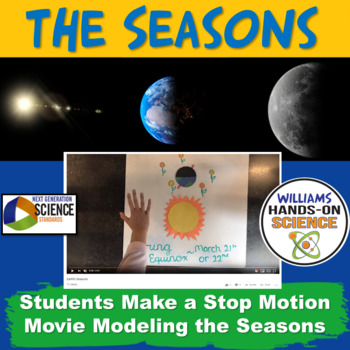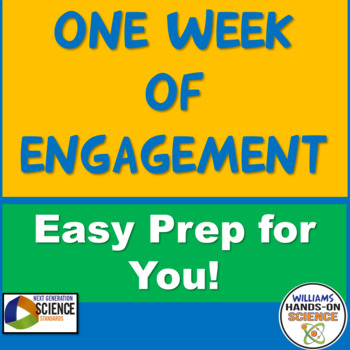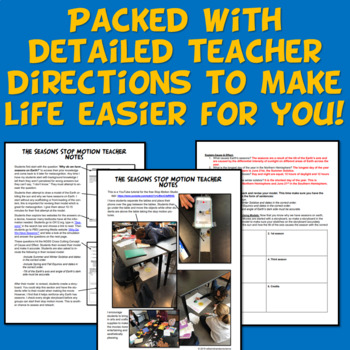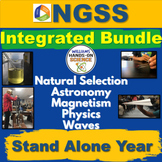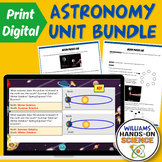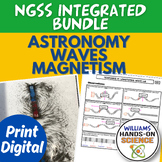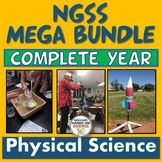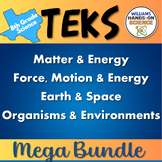Earth Tilt Sun Patterns Seasons Project Based Assessment NGSS MS-ESS1-1
- Zip
- Google Apps™

Also included in
- Looking for a complete, standalone year-long curriculum for integrated NGSS Physics, Energy, Waves, Astronomy, Earth’s History, Science and Engineering Practices, Crosscutting Concepts, and Evolution? Look no further than this student-centered, inquiry-based, hands-on bundle! Designed to align withPrice $205.00Original Price $366.00Save $161.00
- These activities aren’t just you’re ordinary everyday fill in the blank rote worksheets. These are student centered, challenging, hands-on, engaging activities that will wow and motivate even some of the most reluctant learners. I’ve taught, tweaked and improved these products since 2000. I bundledPrice $47.00Original Price $84.00Save $37.00
- You get 14 engaging, hands-on, rigorous activities for 50% when you purchase this bundle and it lasts at least 8 weeks!!! You get an 11-page detailed integrated scope & sequence for easy lesson planning, editable PowerPoints for student instructions and easy classroom management, detailed teachePrice $47.00Original Price $89.50Save $42.50
- This bundle is a time-saving, comprehensive and user-friendly complete year bundle for physical science Teachers that will streamline your teaching experience effortlessly! Every lesson is meticulously planned and just a click away. This extraordinary bundle is a treasure trove of engaging resourcesPrice $176.00Original Price $311.50Save $135.50
- The TEKS 8th Grade Bundle is a comprehensive resource for teaching science mainly in Texas, but it can be used in any state. This bundle includes over 60 hands-on, rigorous, engaging, and phenomena-driven lessons that cover the TEKS standards for 8th grade science. The lessons are designed to help sPrice $160.00Original Price $321.15Save $161.15
Description
Don't be intimidated by "Stop Motion"! I've never made one, but students use the free app and they figure out how to make amazing movies every year! Students will be engaged, excited and students will have a deep understanding of why we have seasons on earth!
There’s no better way to hit the NGSS Science and Engineering Practice of Developing and Using Models than making a movie! This NGSS three dimensional resource covers the Performance Expectation “Develop and use a model of the Earth-sun system to describe the cyclic patterns of the seasons.(MS-ESS1-1)”.
Students make a Stop Motion Animation Movie using a FREE APP on their phone that simulates the Earth's Revolution around the sun and how the tilt of the Earth’s axis causes the seasons. There is everything you need to get started, the only items required by you are white boards and white board markers, however you can have students bring in clay, colored paper and markers themselves. Most kids already know how to make a stop motion movie. It’s so engaging the kids forget that they are even learning astronomy!
Take a look at some student examples below or in the product preview:
https://www.youtube.com/watch?time_continue=77&v=1ymOMYevHTI
https://www.youtube.com/watch?time_continue=3&v=8tiY70eDgv4
https://www.youtube.com/watch?time_continue=23&v=nJZ0zD1-qYQ
Are you not tech savvy? It’s OK! Click on the free tutorial below and the kids figure it out very quickly!
https://www.youtube.com/watch?v=LMwvC4eR9HQ
This resource comes with the following:
-Student Copy
-Key
-Detailed Teacher Notes
-Editable PowerPoint for student instructions and classroom management
The activity contains the following vocabulary:
Orbit
Summer Solstice
Winter Solstice
Fall/Autumnal Equinox
Spring/Vernal Equinox
Axis
Seasons
The NGSS Standards included:
NGSS Performance Expectation (PE)
Develop and use a model of the Earth-sun system to describe the cyclic patterns of the seasons.(MS-ESS1-1)
Disciplinary Core Ideas (DCI)
ESS1.B: Earth and the Solar System
This model of the solar system explains that Earth’s spin on its axis is fixed in direction over the short-term but tilted relative to its orbit around the sun. The seasons are a result of that tilt and are caused by the differential intensity of sunlight on different areas of Earth across the year.
(MS-ESS1-1)
The solar system consists of the sun and a collection of objects, including planets, their moons, and asteroids that are held in orbit around the sun by its gravitational pull on them.(MS-ESS1-2) (MS-ESS1-3)
ESS1.A: The Universe and Its Stars
Patterns of the apparent motion of the sun, the moon, and stars in the sky can be observed, described, predicted, and explained with models.(MS-ESS1-1)
Science and Engineering Practices (SEP)
Developing and Using Models
A practice of both science and engineering is to use and construct models as helpful tools for representing ideas and explanations. These tools include diagrams, drawings, physical replicas, mathematical representations, analogies, and computer simulations .
Cross Cutting Concepts (CCC)
Patterns
Observed patterns in nature guide organization and classification and prompt questions about relationships and causes underlying them.
Cause & Effect Events have causes, sometimes simple, sometimes multifaceted. Deciphering causal relationships, and the mechanisms by which they are mediated, is a major activity of science and engineering.
Systems and System Models
A system is an organized group of related objects or components; models can be used for understanding and predicting the behavior of systems.
Scientific Knowledge Assumes an Order and Consistency in Natural Systems
Science assumes that objects and events in natural systems occur in consistent patterns that are understandable through measurement and observation. (MS-ESS1-1), (MS-ESS1-2)
TERMS OF USE
• All rights reserved by Williams Hands On Science, Inc.
• This product is to be used by the original purchaser only.
• Intended for classroom and personal use only.
• Copying for more than one teacher, classroom, department, school, or school system is prohibited.
• This product may not be distributed or displayed digitally for public view.
• Failure to comply is a copyright infringement and a violation of the Digital Millennium Copyright Act (DMCA).
If there are any errors or questions, please contact me through TpT or email me at:
williamshandsonscience@gmail.com
Thank you for taking a look!
Please follow me on TpT for new products and check me out on Instagram for my products in action!
https://www.instagram.com/williams_hands_on_science/
⭐ Bill Nye Questions Waves Electromagnetic Spectrum
⭐ Claim Evidence Reasoning (CER): Autumn Equinox Can Fall on Different Days
⭐ ESS1.A & B PS4.A & B ESS2.A NGSS Integrated Scale of Universe Card Sort & Video
⭐ ESS1.A MS-ESS1-2 The Universe & Its Stars Astronomy Activity Scale Space Systems
⭐ ESS3.C NGSS Claim Evidence Reasoning: Climate Change is Bad for Humans
⭐ Earth, Moon and Sun PowerPoint and Guided Notes
⭐ MS-ESS1-1: Oreo Moon Phases Lab NGSS Modeling
⭐ MS-PS1-5: Chemical Reactions Simulation Conservation of Mass Close Reading Notes
⭐ MS-PS4-1 MS-PS4-2 MS-PS4-3 Waves Card Sort, Vocabulary Chart and YouTube Clips
⭐ MS-PS4-3: NGSS Analog Vs. Digital Wave Properties 5E Telephone Lab
⭐ NGSS Astronomy Resource Bundle: PowerPoint Labs Guided Notes Prezi Board Game
⭐ NGSS Analog Digital Card Sort PS4.C Information Technologies & Instrumentation
⭐ NGSS Black Holes & Galaxies Claim Evidence Reasoning Graphic Organizer
⭐ NGSS Claim Evidence Reasoning (CER) Big Bang Graphic Organizer
⭐ NGSS Claim Evidence Reasoning (CER) High Frequency Sound Waves
⭐ NGSS Claim Evidence Reasoning (CER) Water Found on Mars
⭐ NGSS Claim Evidence Reasoning The Mysterious Planet Nine Solar System Astronomy
⭐ NGSS Earth's Orbit Around The Sun Stop Motion Movie
⭐ NGSS Electromagnetic Spectrum Waves Doodle Notes & PowerPoint
⭐ NGSS Expanding Universe Claim Evidence Reasoning Graphic Organizer
⭐ NGSS MS-ESS1-2 MS-ESS1-2 Evidence for Big Bang Theory Online CER Activity
⭐ NGSS Middle School Sound Waves Stations & Close Reading
⭐ NGSS PowerPoint Sound, Light, Digital, Analog, Transverse and Longitudinal Waves
⭐ NGSS Waves Electromagnetic Spectrum Properties Worksheet
⭐ NGSS Waves Light Stations Electromagnetic Phenomena

